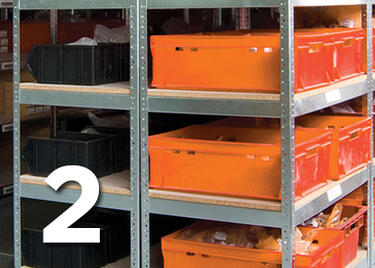The Sections of the Report
These combined reports will give you a comprehensive view of your potential streamlined inventory and will inform you of how many SKUs you can eliminate as well as what actions you should immediately consider to improve safety in your facility.
Inventory Consolidation Summary Report
The Inventory Consolidation Summary Report (Fig. 1) is a one page document summarizing, for each fuse class, the number of bins you currently have, the number of bins you could have by consolidating to Amp-Trap 2000 fuses, and finally the number of bins you could eliminate. Figure 1 illustrates that for this example the user was able to eliminate 136 bins of inventory reducing the total from 230 bins down to 94 bins. Each Amp-Trap 2000 fuse class is listed in the left-hand column. This will allow you to view the overall breakdown of bins consolidated by each fuse class.
Inventory Consolidation Detail Report
The Consolidation Detail Report (Fig. 2) is a multi-page document which validates how the consolidation summary was derived. It identifies each individual part number and its Amp-Trap 2000 equivalent, along with the end user part number, bin number, annual usage, current inventory, min/max levels and physical inventory. By utilizing annual usage and quantity on hand, we will be able to recommend a stocking quantity suitable for your plant use. It is common to find stocking quantities of two different fuses used for the same application. For example, let’s analyze part number A6D15R within Figure 2. We were able to replace four different stocked parts with a single fuse. We were also able to reduce the stocking level by basing the new inventory quantities on the combined annual usage value.
Class H Fuses Identification Report
This report identifies and locates Class H fuses in your inventory (Fig. 3). Class H fuses, also known as “renewable fuses,” are not the proper fuse to install in 99% of today’s applications. The 2005 National Electrical Code Article 240.60(D) states that Class H renewable fuses are not permitted in new installations. Mersen recommends immediately eliminating these fuses from your inventory. Class H fuses have significantly lower interrupting ratings and performance capabilities than Class RK1 fuses and can be harmful to your personnel and equipment. The fuses identified in this report are also included in the consolidation details report.
Duplicate Inventory Report
The Duplicate Inventory Report (Fig. 4) detects equivalent part numbers that are physically stocked in separate bin locations. By locating these part numbers, we can identify how many bins you can eliminate by consolidating like part numbers only. Using Fig. 4, let’s analyze Mersen part number GGC5. In this example, part number GGC5 is stocked in two separate bin locations. The primary focus of the duplicate inventory report is on those products that will not be upgraded to Amp-Trap 2000® fuses such as glass, semiconductor and special purpose fuses.
Additional Information / Follow-Up Report
The Follow-Up Report (Fig. 5) consists of a list of part numbers with missing or invalid information, such as incorrect or incomplete part numbers or descriptions. This report is used to clear up any missing or incorrect information from the audit process. Mersen’s reps and distributors will work with you to correctly identify these fuses.
After the Follow-Up Report has been resolved, we will update the Fuse Control report one final time making sure all information is up to date and accurate. At this time our team will work with you to provide a customized proposal to proceed with the consolidation of fuse inventory.

